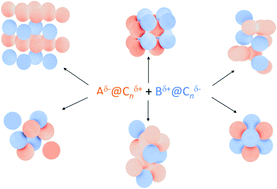Designing stable binary endohedral fullerene lattices
Abstract
Nanoparticle lattices and endohedral fullerenes have both been identified as potential building blocks for future electronic, magnetic and optical devices; here it is proposed that it could be possible to combine those concepts and design stable nanoparticle lattices composed from binary collections of endohedral fullerenes. The inclusion of an atom, for example Ca or F, within a fullerene cage is known to be accompanied by a redistribution of surface charge, whereby the cage can acquire either a negative (Ca) or positive (F) charge. From calculations involving a combination of van der Waals and many-body electrostatic interactions, it is predicted that certain binary combinations, for example a metal (A) and a halogen (B), could result in the formation of stable nanoparticle lattices with the familiar AB and AB2 stoichiometries. Much of the stability is due to Coulomb interactions, however, charge-induced and van der Waals interactions, which always enhance stability, are found to extend the range of charge on a cage over which lattices are stable. Some lattice types are shown to be three or four times more stable than an equivalent neutral C60 structure. An extension of the calculations to the fabrication of structures involving endohedral C84 is also discussed.



 Please wait while we load your content...
Please wait while we load your content...